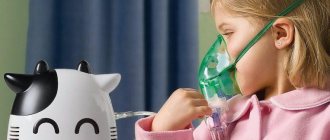The main manifestations and causes of nausea in children. What do the conditions that accompany nausea indicate? What should you do if your child is nauseous?
- Nausea, in itself, is a sign of some disorder or disease in the human body. It occurs under the influence of impulses sent to the brain, signaling a change in a person’s condition
- Therefore, nausea should never be ignored. Especially when it comes to children
- The child's body is especially sensitive to various kinds of irritants. Even if the infection that gets into it is not particularly dangerous, its consequences may be more serious.
How to determine if a child is vomiting?
How to determine if a child is vomiting?
- As a rule, it is difficult to confuse nausea with anything, since in almost all cases it is accompanied by vomiting. Moreover, the fact that the child vomited should please his parents more than the fact that the baby is vomiting, but the causative agent of nausea continues to be in the child’s body and does not come out
- If a child is already talking, it is much easier to detect nausea in him - he can simply report it verbally. At least he can make it clear that something is wrong with him
- If the baby is still just a baby, then his mother can detect nausea only after vomiting. Babies burp very often even in their normal healthy state. However, such phenomena are not so frequent. If the baby burps repeatedly or in a different way than usual, his mother should be wary
- In addition, nausea in an infant may be accompanied by crying or screaming.
Mechanism of nausea
The human body is a rather complex system, the slightest disturbance in which manifests itself in a wide variety of symptoms. Among them are nausea and vomiting in the morning. Regardless of the causes of the pathology, these symptoms cause discomfort to the patient and worsen his well-being.
Vomiting in the morning can indicate the development of various diseases. Moreover, the frequency of this reflex is directly dependent on the factors that cause it, the age and gender of the patient, as well as the individual characteristics of his body.
Most often, vomiting in the morning is observed in children. Slightly less common in women. In men, such a symptom occurs very rarely.
However, vomiting is not a pathology at all. It is a complex defense mechanism that unconsciously works in a person at a reflex level. Outwardly, such a process is nothing more than an uncontrolled release of stomach contents in most cases through the oral cavity, and sometimes through the nasal passages. The formation of the gag reflex occurs due to the influence of peripheral or central stimuli on a special center called the gag center. It is located in the brain. It is from here that the muscular tissues of the organs receive commands and impulses. Their performers are the diaphragm of the stomach and the abdominal press. As a result, muscle contraction occurs. This process helps to expand the esophagus and open the entrance to the stomach. The contents of this organ are pushed out, which is why vomiting occurs.
Why does my child have nausea and drowsiness?
Why does my child have nausea and drowsiness?
The answer to this question will be a list of diseases that may be accompanied by nausea and drowsiness in a child:
- worms and other parasites
- psycho-emotional disorders
- thyroid problems
- exhaustion of the body
- dehydration
- pancreatic disease
- oncological diseases
- spinal problems, poor posture
- changes in blood sugar levels
- brain diseases
- problems with the vestibular system
Having identified signs of nausea and drowsiness in a child, you should not immediately panic and associate these symptoms with dangerous diseases. First you need to show your baby to the doctor.
Types of pathological condition
Before you start stopping vomiting, you should determine its type:
- Functional is the safest. It is the body's reaction to food that is not suitable. If a child is vomiting without fever, this condition can be treated at home, subject to medical recommendations.
- Cardiac – develops against the background of heart failure, the skin turns pale, and appetite worsens. To stop this condition, only qualified medical assistance is required.
- Abdominal – develops due to inflammation in the abdominal cavity.
- Cerebral - develops in diseases of the brain, while the reflex is voluntary and most often appears in the morning.
- Psychogenic – develops due to a sharp change in the emotional background. This usually happens after eating; weakening, paleness of the skin and increased heart rate appear.
What does severe nausea in a child mean?
Severe nausea in a child
- Severe nausea in a child may be a sign of one of the above diseases. Or maybe it also indicates the baby’s usual fatigue. Perhaps during the day he had to experience many very exciting or even several stressful events
- At the end of the day, such a child may feel unwell and even nauseous.
- If nausea does not stop over a long period of time or returns regularly, such a baby should be taken to the doctor.
Treatment of morning sickness
Any therapy can only help if a doctor correctly diagnoses and prescribes an appropriate course of treatment, which takes into account the underlying illness and its severity.
In this case, the following groups of medications can be prescribed:
- neuroleptics, including diphenhydramine and diazolin;
- dopamine-type receptor blockers (cerucal);
- antiemetics (motilium);
- sorbents (enterosgel, polysorb, activated carbon);
- means that restore water balance (rehydron).
There is no point in self-medication. A specialist should indicate to the patient the need to use a particular drug. For example, having identified low blood pressure among the causes, treatment sometimes begins not with taking pharmacological agents at all. After all, sometimes the problem can be eliminated by changing the patient’s lifestyle. And only in the absence of the desired effect, pharmaceutical drugs are recommended.
Abdominal pain and nausea in a child, causes
Abdominal pain and nausea in a child
Abdominal pain and nausea in a child can be caused by various types of diseases of the internal organs. These organs include the digestive and genitourinary systems, liver and intestines, as well as the lungs.
Here is a list of diseases that can cause similar symptoms:
- constipation
- intestinal disorder
- appendicitis
- inguinal hernia
- hepatitis
- cholecystitis
- stomach or duodenal ulcer
- tuberculosis
- worms
- poisoning
- kidney disease
Why do you feel sore in the morning?
The most well-known cause of morning sickness is, of course, toxicosis in the first trimester of pregnancy.
This is a kind of protective mechanism that serves to protect the mother and, accordingly, the fetus from consuming potentially dangerous products. This is not a pathology, but one of the signs of a normal pregnancy. If nausea in the morning during pregnancy causes discomfort, you need to eat small portions of foods that do not cause rejection, drink as much liquid as possible (still mineral water, herbal teas, ginger tea). Hospitalization is required only in cases of severe deterioration in health and dangerous weight loss.
If your symptoms take several days to develop after you suspect you are eating, you may have a bacterial infection in your intestines. Infections with one of these types of bacteria may require treatment with antibiotics. If you have multiple episodes of vomiting or diarrhea, you may become significantly dehydrated as a result of food poisoning. Treatment with intravenous fluids may be required. If you notice dizziness or feel like you are losing fluid faster than you are taking in fluids, you should contact your doctor immediately.
But most people who experience morning sickness are not pregnant women. For them, nausea in the morning is not the norm, but a sign of problems with the body. Moreover, morning sickness may indicate disorders not only of the digestive system, but also of the cardiovascular system.
If you feel sick in the morning, be sure to consult a therapist who will prescribe all the necessary tests and give you a referral to a specialist.
Your doctor's care is especially important if you are older or have heart disease or diabetes. Nausea and vomiting are common side effects of many different medications. Here are the types of medications that most often cause nausea or vomiting. Even if your medication here is not a common cause of nausea, one of the first steps in your evaluation should be a discussion with your doctor or pharmacist about your recent medication change.
Medicines that usually cause nausea. Since you have determined that it is possible that you may be pregnant, testing it through a urine pregnancy test should be the first step in your evaluation. Pain or tenderness associated with a swollen belly may occur if you have a blockage anywhere in your intestines.
One of the possible causes of morning sickness is helminths (worms).
To diagnose helminthiasis it is necessary to undergo tests. If the diagnosis is confirmed, the doctor will prescribe treatment, and the morning sickness will go away after complete recovery.
Feels sick in the morning
Morning sickness can be a consequence of problems with the gastrointestinal tract.
Morning sickness can accompany gastritis, peptic ulcers, and gallbladder diseases. In this case, we exclude more acute diseases, such as pancreatitis, appendicitis, intestinal infections and poisoning, since, in addition to nausea, they are accompanied by vomiting, fever and pain - and these are more compelling reasons for concern than morning sickness.
When is nausea a sign of illness?
Is your stomach irritating?
Abdominal pain and nausea or vomiting can occur for a variety of reasons. If the pain is severe, consult a doctor immediately. Remember that recurring episodes of nausea and vomiting can occur due to a variety of medical reasons, such as a serious illness. Vomiting can deplete your fluids and electrolytes, so repeated vomiting requires treatment if dizziness or swallowing occurs as a result. Please take the time today to arrange a medical assessment if you have not already done so. For peptic ulcers and gastritis
Nausea may get worse after eating.
Nausea in the morning can be accompanied by heaviness in the stomach, heartburn, and a burning sensation in the upper abdomen. In gallbladder disease,
nausea occurs during meals and may be accompanied by heartburn, increased gas production and a metallic taste in the mouth.
To make an accurate diagnosis, a blood test (general and biochemical), gastroscopy, and ultrasound of the abdominal organs are performed. Depending on the diagnosis, treatment is prescribed, most often antibiotics. Most likely, you will have to follow a diet and give up some foods. By the way, nausea in the morning can also be a sign of problems with the liver or kidneys.
Gastritis is an irritation that causes a “raw” stomach. The stomach can be irritated by medications, alcohol, or infection. Avoiding alcohol and spicy or acidic foods may be helpful, and anti-acid medications may also help. A viral infection that primarily affects the stomach and intestinal tract is known as “gastroenteritis.” This condition is sometimes called "stomach flu." Many different viruses can cause gastroenteritis. Most also cause diarrhea, but this symptom may be followed by symptoms of nausea, vomiting and abdominal pain.
Morning sickness can be caused by vegetative-vascular dystonia (VSD).
This is a fairly common disease.
A cardiac ECHO will help you confirm the diagnosis. We wrote in more detail about the treatment of VSD in the article. The tips described there will help you if regular morning nausea is caused by VSD. Also, morning sickness can occur with hypertension,
accompanied by increased fatigue, dizziness, and headaches.
Ketoacidosis puts life at risk because it is associated with severe dehydration. It causes abdominal pain in the central and upper abdomen and back pain. Dysmenorrhea. If you are a woman and you are in the early days of your menstrual cycle, nausea, vomiting and abdominal pain may be caused by hormonal changes that are a normal part of the menstrual cycle.
Diseases of the heart and blood vessels
You may have a small or large bowel obstruction! If you are unable to hold down food or liquids, or if you are unsuccessful when you try to remove stool, you should be examined by your doctor today. An intestinal obstruction can occur when a strand of fibrous scar tissue becomes coiled around it. Less commonly, the intestine can become blocked if part of the intestine becomes a "hernia" that bulges through an opening in the abdominal wall muscles. The intestines may also be blocked by a tumor.
Morning sickness may be associated with problems with the vestibular system.
In this case, it occurs suddenly with a sharp change in body position. It is enough to suddenly get out of bed or even roll over to the other side to make you feel sick. Morning sickness may be accompanied by dizziness, loss of balance, tinnitus, or nystagmus (involuntary eye movements that make it difficult to focus). To diagnose and treat problems with the vestibular system, you should consult with an otolaryngologist and neurologist.
Symptoms of intestinal obstruction include nausea and vomiting, abdominal pain and bloating, and in some cases, failure of gas to pass through the rectum. Symptoms include craving bowel movements that do not result in a successful stool, no bowel movement in the last two or three days, or a feeling of blockage in your rectum. When nausea or vomiting is associated with headache, dizziness, blurred vision or blockage, it may be a benign cause or a dangerous cause.
You should seek emergency medical help if your symptoms are severe, if you have visual problems that have not yet been assessed and explained, if your headache or nausea lasts more than a few hours, or if you have numbness, weakness, mental confusion, or difficulties Walk or talk normally.
The causes of nausea in the morning may be endocrine system disorders,
for example,
hypothyroidism
is a lack of thyroid hormones. In addition to nausea, it is accompanied by fatigue, drowsiness, memory problems, weight gain with decreased appetite, and increased chilliness. A blood test for hormones will help identify hypothyroidism, and an immunologist will prescribe treatment.
High fever and nausea in a child
High fever and nausea in a child
The presence of high fever and nausea, as a rule, indicates that an infection has settled in the child’s body, and he is trying his best to get rid of it. An increase in body temperature provokes a fight against viruses inside the body, and nausea occurs in order to bring them out.
Symptoms such as high fever and nausea in a child may be signs of the following diseases and conditions of the baby:
- rotavirus infection
- poisoning
- intestinal infection
- increasing acetone levels
- colds and viral infections
- meningitis
- extreme stress
- gastrointestinal diseases
- allergic reaction to medications
How to help your baby at home
Every parent should learn basic first aid for a child who is feeling nauseous or vomiting.
It is the correct actions of mom or dad that guarantee the absence of negative complications and alleviate the condition of the little patient.
What should parents do when their child is vomiting? There are several effective recommendations:
- The first step is to place the child on either side, and place a napkin or towel under his cheek. This should be done before each urge to vomit.
- Infants under one year of age should be picked up and placed in a horizontal position.
- It is advisable not to feed the child until the doctors arrive.
- You can give an antipyretic tablet only if the reading on the thermometer exceeds 38 degrees.
- When there is a urge to vomit, you need to sit the child on a stool and tilt his body slightly forward. This solution will prevent vomit from entering the lungs.
- When a baby vomits, his mouth should be constantly rinsed with purified water, washed and changed more often.
- You should not scream or cry in front of your child - this will provoke panic in him. Parents must do everything clearly and quickly.
- During an attack, you can give a child up to one year a small amount of water.
- In addition to water, it is allowed to give the child Regidron or Oralit - glucose - salt products.
- If we talk about medications, then without consulting a specialist, a child can only use Smecta.
- When diarrhea occurs, a child who is also nauseous needs to change his underwear regularly.
- Parents should collect a small amount of vomit in a clean container and give it to the doctor for examination.
Just in case, it is recommended that mom prepare a bag with the things necessary for hospitalization.
If the child’s nausea is not accompanied by fever or diarrhea, then parents should closely monitor the child’s condition in order to promptly notice dangerous symptoms.
Do not forget that it is better not to take your child to the hospital by personal transport, but to call an ambulance.
This is explained by the fact that the baby may become even more upset in the car, which will significantly worsen his well-being.
What to give your child for nausea?
What to give your child for nausea?
First of all, a child with symptoms of nausea should be seen by a doctor. Only he will be able to establish the correct diagnosis and prescribe adequate treatment.
There are a number of means that allow your baby to get rid of such an unpleasant phenomenon as nausea:
- If a child feels sick some time after eating, this may indicate poisoning or poor quality food. In this case, you need to give the baby a large amount of water (at least a third of a liter) and induce vomiting.
- Decoctions and infusions of herbs like yarrow, dill and parsley, chamomile, dandelion and wormwood will help get rid of the symptoms of nausea
- Nausea from motion sickness in transport will disappear with the use of mint chewing gum or lozenges
- Some babies experience nausea during active play immediately after eating. Therefore, it is better to give the baby a little rest after eating, and only then allow him to play.
- If a child’s nausea is associated with strong emotions, soothing teas based on mint, lemon balm and lemon can help him
- You should not give sorbents and anti-nausea medications to your baby without a doctor’s permission.
Medicines to relieve nausea
All medications that can suppress the gag reflex, as well as normalize the activity of the digestive tract, can be given to a child only with the permission of a doctor and after the causes have been identified. The modern pharmacological industry offers a large selection of antiemetics. The most common sorbents in pediatrics are:
Children under 2 years old can be given Motilium in suspension, after 2 years old - Cerucal. For a child 2 years of age and younger, No-spasm and Domperidone can be used to combat nausea. Children over 5 years old are allowed drugs such as Loperamide and Imodium.
According to parents, “Dramina”, “Kokkulin” help well against motion sickness in transport, and “Avia-More” for school-age children. All these drugs are classified as homeopathic, so they are not recommended for skeptical parents. It is better for them to get a prescription from their doctor for a full-fledged medicine - Relanium or Prazepam.
Video: What to give your baby with acetone?
Video: Intestinal infections
source: BabyBen.ru
When a baby gets sick, the whole family begins to worry. At the first manifestations of the disease, you should immediately contact a specialist. But mothers are advised to know the main causes of nausea and methods of treatment.
Nausea in a child is a consequence of a variety of reasons. This unpleasant condition does not always manifest itself from poisoning, as most parents think. In this article we will find out why a child feels sick, what it depends on, what causes the illness and how to help the baby after the first symptoms appear.
Morning vomiting accompanied by diarrhea
When a whole complex of symptoms manifests itself, the body will be affected in a more complex way. This is also observed with vomiting, which occurs simultaneously with diarrhea. In relatively healthy people, this phenomenon occurs infrequently and can be explained quite simply. The fact is that some foods are not absorbed very well by the body. This especially often happens against the background of overeating, when combining food with alcohol, and also when taking it immediately before a night's rest.
A complex combination of symptoms is also observed during the development of certain diseases. And this can be not only vomiting with diarrhea, but also abdominal pain. Most often, nausea with diarrhea occurs with:
- Infectious diseases. Among them are bronchitis, pneumonia, tonsillitis, ARVI. Morning sickness, vomiting, diarrhea and acute pain in the abdomen are caused by intestinal infections provoked by pathogenic microorganisms that enter the gastrointestinal tract with stale food or dirty hands. Reproducing bacteria release toxic substances during their life processes. Pathologies of the urinary system can also cause morning sickness with diarrhea. Thus, with infectious kidney diseases, intoxication develops, which causes an increase in body temperature. In addition to morning vomiting and diarrhea, ailments of the urinary system are also accompanied by swelling of the face, which can be observed after sleep. If such symptoms occur, you will need to consult a therapist. With an accurate diagnosis, antibiotics and sorbents will help get rid of the disease.
- Malfunctions of the digestive organs, namely the gallbladder, pancreas, kidneys and liver.
- Experienced chemical and food poisoning.
- Reactions of the central nervous system to brain injury, as well as stress.
- Side effects of medications taken by the patient.
- Toxic effects.
Identification by a doctor of a specific factor that provokes morning sickness and diarrhea will help identify the cause that affects the body in a similar way.
Causes
The reasons for the feeling of nausea are different. They can be caused by poisoning, overeating or stress. Before starting treatment, it is necessary to identify what caused the formation of this disease. The causes may be common or situational.
Common Causes
- Food poisoning. It can be caused by eating low-quality or expired food. Food that has not been stored properly contains pathogenic microorganisms. When they enter the gastrointestinal tract, they begin to negatively affect and form toxins. Very often, nausea manifests itself very sharply, 3-4 hours after eating. The baby begins to feel unwell and slightly dizzy. First, nausea appears, then vomiting and diarrhea. In most cases, nausea in a child is accompanied by an increase in body temperature to 37-38°C.
- Intestinal infections. At the moment, a very large number of intestinal pathogens are known. These include salmonella, E. coli, staphylococcus, and rotaviruses. Sources of infection are animals or sick adults. A baby can transfer infection to his body from a carrier through toys, household items, drinking water, and food. At the first stage of the disease, symptoms are minor. But the baby has slight dizziness, lethargy, and general weakness. Once tired, the child may become moody, overexcited, or irritable. Only after this does nausea and vomiting appear. Then pain in the stomach, bloating, and increased gas formation in the intestines occur. Undigested food particles remain in the stool and vomit. Diarrhea forms, body temperature rises to 37.5°C. In rare and very severe cases, vomiting of bile and fever up to 40° may occur. The course of the disease depends on the type of infection.
- Acute infections. These types of infections are not associated with the digestive system. The main symptoms include vomiting, nausea, dizziness, and a slight increase in temperature up to 37°C. The manifestation of such symptoms occurs in severe stages of the disease. Pathologies usually include pneumonia, various forms of influenza, acute respiratory viral infections, and pyelonephritis. The main difference between acute infections and intestinal infections is the preservation of stool in an unchanged state. Children do not develop diarrhea or diarrhea. Vomiting of bile is excluded.
Situational reasons
- Nausea associated with traveling in public transport. This condition manifests itself due to disorientation in space. There is a disruption in the functioning of the inner ear. When your body position changes, signals are sent to the brain. Based on the information received, the body's balance is disrupted. Shaking, chaotic traffic movements and changes in speed lead to a malfunction, which manifests itself in the form of nausea. In most cases, the causes of motion sickness lie in the child’s poor health. Before the trip, doctors recommend avoiding eating too fatty, overcooked and heavy foods, which can aggravate the feeling of nausea. It is recommended to eat a green apple or pickled cucumber. You can drink herbal tea made from mint or lemon balm.
- Foreign body in the stomach. When a foreign object is in the body, it is called a foreign body. It can enter a child's body by ingestion or inhalation. In rare cases, objects are introduced during surgery or penetrating wounds. After the object hits the baby, nausea and vomiting begin. Such symptoms appear within a few minutes. Complications may include vomiting bile, bleeding, perforation of the stomach wall, difficulty breathing, and dizziness.
- Surgical pathologies of the digestive tract. Nausea may be one of the signs of acute inflammation of appendicitis. The organ is located in the lower abdomen. When inflammation occurs in this area, sharp, unbearable pain occurs. Symptoms may include dizziness, diarrhea, and an increase in body temperature up to 38°C.
- Diseases that affect the central nervous system. Very serious and dangerous diseases include encephalitis or meningitis. The main symptom of such diseases is nausea. It is worth considering that vomiting does not bring the desired relief. The general condition of the child is disturbed. There is weakness and dizziness. Often there is no appetite at all. The baby becomes whiny and capricious. There is a decrease in motor activity. Photophobia and headaches begin. There may be sudden screams. In severe stages of the disease, vomiting of bile, loss of consciousness, and complete refusal of food and water are observed. The child begins to have seizures. The temperature rises to 40°C.
- Nausea after vigorous activity. This condition may occur after active games or sports. The child feels sick after playing football, hockey, ice skating, running, or doing pull-ups on the horizontal bar. When a child is prone to this type of nausea, it is necessary to limit sports activities or physical activity. It is necessary for the baby to drink more water.
- Nausea in the morning. If a child feels sick in the morning, then this manifestation indicates hunger. The feeling of nausea can be completely eliminated simply by having breakfast. You can give your baby fresh fruits, dairy products or infusions of medicinal herbs. Also, nausea in the morning can indicate intracranial pressure. Therefore, if the feeling of nausea does not go away after a hearty breakfast, then a neurologist will be able to determine the true cause of this manifestation.
- Nausea after severe nervous tension. Very often, nausea occurs after a nervous breakdown. The emotional state is affected by a change of situation, a quarrel, a fight. In this case, the child must be provided with moral support. This nausea does not last long. You can give your baby sedatives or brewed herbal teas. You can make decoctions from rose hips, cones, and currant leaves.
What is considered vomiting
The gag reflex refers to spasms of the digestive organs and abdominal muscles. Blocking the opening leads to the fact that the food in the stomach goes up the wide esophagus, which is why the baby vomits.
Most often, vomiting occurs through the mouth, but there are cases when the mass comes out through the nose. The brain is responsible for such actions, more precisely, its posterior sections, in which the vomiting center is located.
Signs of vomiting in both adults and children can be noticed even before the process of vomiting.
The phenomenon is preceded by the following symptoms: frequent swallowing of saliva, heaviness in the throat, epigastric pain, increased secretion of saliva.
When vomiting, both undigested food along with gastric contents and vomit with pus, blood, mucus and bile can come out.
During nausea, the child may experience other unpleasant sensations. They vary depending on why the urge to vomit occurred:
- Digestive problems: frequent vomiting, excessive salivation, abdominal pain.
- Pathologies of the nervous system: the child’s vision becomes dark, dizziness, drowsiness appears, breathing and pulse quicken. There is a lack of air.
- Intoxication of the body: constant weakness, excessive sweating, frequent heat or cold on the skin, a slight increase in temperature, weight loss.
If the child is still too young to explain what is bothering him, then parents may suspect nausea due to the baby’s frequent whims, refusal to breastfeed, increased restlessness and loud crying.
In addition, the baby sweats a lot, and the limbs remain cold.
Combinations with other symptoms
- Nausea and fever may indicate the presence of intestinal obstruction, indigestion, irritable bowel syndrome, or acute appendicitis.
- Nausea and headache indicate increased intracranial pressure, migraine, fatigue, stress, brain tumor, meningitis, borreliosis.
- Nausea and diarrhea indicate the presence of toxic substances in the child's body. This manifestation may be a consequence of overeating and consumption of heavy foods. It may also indicate the presence of cancer, stressful situations, allergies or intolerance to certain foods.
- Nausea and dizziness indicate labyrinitis, cervical osteochondrosis, vestibular neuritis, Meniere's disease, head injuries, and pathology of the eye muscles. May be a consequence of taking medications or stressful situations.
- Bile nausea indicates liver disease, bile reflex, gallbladder or bile duct disease. Nausea with bile indicates an acute form of pancreatitis, cyclic vomiting syndrome, and small intestinal obstruction.
Determining causes based on characteristic signs
Constant malaise and vomiting in the morning require detailed study. This will allow us to find out the reasons for this condition.
It is worth noting that nausea and vomiting are the main symptoms that are taken into account by specialists in the process of diagnosing pathology. The following factors create the conditions for such a physiological state:
- Malfunctions of the central nervous system. The cause of this condition may be complications that arise after the patient has suffered certain infectious diseases (encephalitis, meningitis) or injuries (burns, concussions). Many people are familiar with the condition of migraine. This pathology, which causes unbearable headaches, is usually accompanied by morning sickness. It does not go away even after vomiting. Sleep and painkillers will help the patient cope with this problem. Another dangerous disease included in this group is cerebral stroke. It develops in the early morning and is accompanied by nausea and vomiting. In addition to these signs of such a formidable illness, the patient complains of dizziness and changes in blood pressure can be observed. In addition, a number of other specific symptoms arise, which depend on the location of the ischemic lesions. So, a person exhibits facial asymmetry, the tongue deviates to the side, the strength in the arm decreases, or he cannot lift one of his legs. The emergence of a walking clinic requires urgent medical attention. Disruptions in the functioning of the central nervous system also occur after traumatic brain injuries, provoking the occurrence of microdamages in the structure of the brain substance. This causes changes in the functioning of the vestibular apparatus, which is reflected in unsteadiness of gait, as well as nausea and vomiting, which does not bring relief. Such changes begin in the morning hours the next day after the injury. Making a correct diagnosis is possible after examining the patient by a traumatologist and neurosurgeon.
- Toxic effects. Nausea and vomiting in the morning occur due to existing renal or liver failure, drug or food poisoning, aggressive effects of chemical poisons, as well as benign or malignant neoplasms. The most common oncological diseases that are accompanied by such symptoms are stomach cancer (in this case, in addition to nausea, there is also an aversion to meat products, as well as a significant decrease in the patient’s weight), liver and gall bladder cancer (with this pathology, a dull pain occurs in the area right hypochondrium), pancreatic acenocarcinoma (characterized by the rapid development of wasting), dymphoma and leukemia. Vomiting in the morning often occurs due to intoxication of the body with products formed due to tumor growth. Very often, such a symptom is a complication of chemotherapy. An oncologist is responsible for diagnosing and prescribing a course of treatment when malignant tumors occur.
- Pathologies of the gastrointestinal tract. Vomiting in the morning on an empty stomach often occurs with gastritis or stomach ulcers. In this case, nausea is accompanied by hunger pain. Does not help improve your condition and food intake. After eating, nausea begins to worsen, and a feeling of fullness occurs in the stomach. Pancreatitis also manifests itself as morning sickness. Simultaneously with this phenomenon, the person feels pain in the right side of the abdomen. The condition worsens after eating spicy, fried and fatty foods.
To diagnose the causes of morning sickness in a patient, specialists pay attention to the format of the vomit, whether it contains fragments of food, particles of blood or bile. The question of the presence of odor or taste in the mouth is also clarified.
What to do?
It is necessary to take any action after the first symptoms appear only after the causes of the illness have been identified. Self-medication is not recommended. Incorrect diagnosis and self-treatment at home can cause side effects. You cannot risk the health and life of a child. Parents need to contact a professional specialist. Only after consulting a doctor can you perform the following steps.
First aid
- If a child is vomiting, the first thing you need to do is call an ambulance.
- The child is then placed on his side. You should not place your baby on his back, as in this case there is a risk that he may choke on vomit.
- You can give your baby decoctions of medicinal herbs. Mint, lemon balm, fireweed, and field chamomile are perfect. They will help prevent dehydration. Newborns and babies under one year of age can be given two teaspoons of liquid every 5-15 minutes. Small children from one to three years old can be given four teaspoons of liquid at identical intervals. Older children are given two to four tablespoons.
- When the baby’s condition is assessed and there is no threat to life, gastric lavage can be done after taking the liquid.
- Children can be given medications that eliminate the disease and improve the general condition of the child. But in order to relieve the first symptoms, you need to consult a specialist.
- When the baby’s condition worsens, there is blood in the vomit or the baby is vomiting bile, it is necessary to urgently take the child to the hospital without waiting for an ambulance. Often the medical team does not arrive on time. And delay can cause not only side effects, but also death.
In what cases should you call an ambulance?
- It is mandatory to call an ambulance for children under three years old;
- A doctor is called if the child is nauseous for a long period;
- Consultation with a specialist is necessary if the baby vomits bile;
- If during feeding the body does not accept food and intake, responding with a gag reflex; If the baby has chills, dizziness, convulsions, severe headaches;
- If there are blood clots in the vomit;
- If the child’s body is severely dehydrated;
What can you give?
A single attack of nausea involves providing the child with first aid and restoring the body with special medications .
If the baby’s condition quickly recovers, then medications can be replaced with some alternative medicine recipes.
If regular attacks occur, it is necessary to consult a specialist, undergo an examination and be sure to find out the cause of nausea.
Drugs
Medicines intended to eliminate attacks of nausea have age restrictions. This nuance must be taken into account when independently selecting drugs.
If the remedy does not correspond to the age category of the child, then taking it will not alleviate, but will aggravate his condition.
The best option is to consult a doctor. If there are pathological processes in the baby’s body, treatment of nausea with antiemetic medications will not be limited. There will be a need for complete and complex therapy .
Examples of medications to relieve nausea in children:
- antiemetics (Hofitol, Cerucal, Kokulin);
- first aid for food poisoning (Activated carbon);
- antacids (Rennie, Gaviscon);
- anti-motion sickness drugs (Histamine, Dramamine);
- medicines to strengthen the muscles of the stomach (Ondansetron).
Folk remedies
Effective remedies for nausea are folk recipes based on medicinal herbs .
Such options for eliminating an attack can only be used when it occurs once.
If nausea occurs regularly, then it is necessary to carry out complex therapy for the existing disease. Folk remedies can be used as a supplement to the main course of treatment .
Decoctions based on the following plants can be used as anti-nausea remedies
- fennel;
- Melissa;
- St. John's wort;
- calendula;
- ginger;
- peppermint.
Treatment
Treatment and elimination of nausea depends on the diagnosis.
First, it is necessary to identify the cause of the disease, and then begin treatment.
- If you eat low-quality food and experience the first symptoms of poisoning, it is recommended to do gastric lavage. To do this, use solutions of soda or potassium permanganate. It is important to start doing gastric lavage before toxins begin to be absorbed into the blood. Otherwise, serious side effects will be detected. Children can use Smecta. The active action of this drug occurs in the intestines. The use of dill water is allowed as a folk remedy. One tablespoon of dill seeds is poured into two glasses of boiling water. Leave for 15 minutes. Consume one tablespoon three times a day. It is also allowed to make lemon water with the addition of lemon, orange or tangerine zest.
- In the presence of intestinal infections, the main symptom is dehydration. The child may feel a lack of fluid in the vascular system. Therefore, it is necessary to replenish fluid as soon as possible. Babies are given it during feeding, older children consume water in 2-3 doses per hour. As a treatment, you can do gastric lavage with a weak solution of potassium permanganate. Infusion therapy may be prescribed, which includes the administration of medicinal solutions intravenously. The use of antibiotics is permitted. Cephabol or Claforan are perfect. As a traditional medicine, children can be given a decoction made from calamus root. The product not only relieves dizziness, nausea, and stomach cramps, but also eliminates infectious agents. 10 grams of crushed roots are poured into two glasses of boiling water. Then simmer over low heat for 10-15 minutes. Then the broth is filtered and taken up to six times a day. You can make lotions from the product and use it to wash wounds.
- Acute infections have a short incubation period. Therefore, the longer treatment is delayed, the more difficult it will be to cure the baby. When the first symptoms appear, it is recommended to immediately consult a specialist. The doctor may prescribe medication and physical therapy. Patients need to follow a diet that promotes the fastest possible recovery of the body after illness. It is necessary to consume large amounts of vitamins and beneficial microelements. Activated carbon and Enterosgel for children are allowed to be used as medications. Oak bark can be used as a folk remedy. It is poured with one liter of boiling water and simmered over low heat for ten minutes. Strain and consume up to six times a day. The decoction eliminates dizziness, nausea, and the feeling of vomiting.
If it comes to vomiting or there is a suspicion of this, then be sure to watch this video
Treatment of nausea and vomiting
Therapeutic measures for children before and after one year include taking medications, following a diet and using traditional medicine.
Use of medications
If a child is feeling nauseous, then after making a final diagnosis, the doctor may prescribe certain medications that will eliminate the causes and relieve the little patient of these symptoms.
In such cases, it is customary to take antiemetics, which relieve spasms and have a positive effect on the brain.
These include Cerucal, Motilium and Domperidone. In addition, experts recommend taking the following medications:
- Regidron, Gastrolit, Gidrovit are solutions based on glucose and salts that prevent the process of dehydration.
- Polysorb, Enterosgel are sorbents that cleanse the stomach in case of poisoning.
- Sedative barbiturates are prescribed for children under one year of age who cry a lot and thereby strengthen their gag reflexes. It is recommended to give this remedy in cases where the vomit cannot come out normally due to the baby’s hysterics.
- Neuroleptics are drugs that eliminate the causes of cerebral vomiting.
- Antibiotics are prescribed only by a doctor after a pathological diagnosis.
It is worth considering that any medicine can only worsen the situation if taken without consulting a specialist. For proper treatment, the child must be shown to a doctor.
Prevention
Nausea in the morning in a child develops during various pathologies within the body. Therefore, the prognosis varies depending on the specific disease.
It is possible to avoid unpleasant symptoms if you follow simple preventive measures:
- monitor the child's nutrition;
- spend a lot of time outside;
- pay attention to the child’s emotional state;
- see a doctor for medical examinations every 6 months;
- seek help if initial symptoms of the disease occur.
When a child often feels sick in the morning, parents should seek help from a specialist who, after analyzing complaints and examining them, prescribes the necessary clinical and instrumental examinations to help identify the cause of the ailment or refers them to another specialized doctor.
Self-treatment should not be carried out, as it may not produce results and often aggravates the disease.
Associated symptoms
Possible symptoms depending on the cause of the illness:
- cough;
- runny nose;
- general weakness;
- headache.
Diseases of the gastrointestinal tract are accompanied by:
- Diarrhea or constipation, other problems with bowel movements.
- Increased body temperature.
- Vomit is yellow in color due to poisoning, appendicitis or infection.
- Red vomit is a sign of internal bleeding or damage to the mucous membranes. However, the child could have eaten a product with dye that gave the same reaction.










